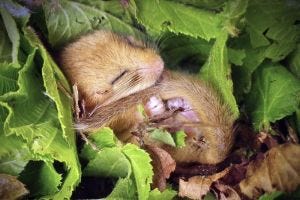Dormice multiply in UK after volunteers offer helping hand
Dormouse babies are scurrying through woodlands of the United Kingdom where they haven’t been spotted in decades, thanks to help from volunteers and charities committed to reintroducing the tiny rodents throughout the countryside.
In summer 2023, People’s Trust for Endangered Species released 38 captive-bred dormice at a woodland on the Calke Abbey estate in Derbyshire, according to a PTES press release. By fall, volunteers observed several litters and nest boxes packed full of dormice.
This is impressive considering dormice are nocturnal, shy, and notoriously hard to find.
“The discovery of new litters – as well as the many nests – shows signs of breeding, which is excellent news,” said PTES. “Additionally, finding independent young dormice shows that the dormice born in the woods over the summer have already begun supporting themselves and are thriving in this habitat.”
In 2021, volunteers released 69 captive-bred dormice and installed several hundred nest boxes at Eaves Wood and Gait Barrows National Nature Reserve near Morecambe Bay as part of a project called Back on Our Map (BOOM) in partnership with PTES. Surveys in 2023 showed these dormice had also multiplied, with hundreds of sightings over a two-year period.
It can take more than ten years to determine if a reintroduction has proven successful, but these are encouraging signs. Dormouse populations have fallen 70 percent since 2000 in Britain. PTES is advocating for the dormouse to be listed as “endangered” rather than “vulnerable” under the International Union for Conservation of Nature.
Dormice hibernate for up to six months per year to survive the food shortages of winter. They are primarily arboreal and avoid travelling on the ground. This means disruption to their bushy habitat, like a road or pasture, will limit how much they travel. Populations are at risk of inbreeding if they can’t connect with other populations through a lush hedgerow or woodland. Farmers are being encourage to reestablish hedgerows and allow existing hedgerows to grow full.
Since 1993, PTES and partners have released over 1,112 hazel dormice into 25 different woodlands in 13 counties. Dormice are now thriving in six English counties where they’d previously been lost, most of which are in the Midlands or northern England.
In Morecambe Bay, National Lottery players supported the £2m project, which included other native wildlife and plant restoration, alongside several other public, private and charitable sector organizations. Led by the University of Cumbria, BOOM worked closely with Morecambe Bay Partnership, and lead partners, Cumbria Wildlife Trust, Natural England and Forestry England. Over six hundred volunteer days made the project possible.
The post Dormice multiply in UK after volunteers offer helping hand appeared first on EARTH HOPE.






